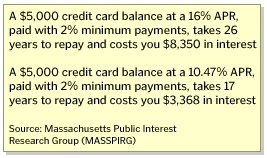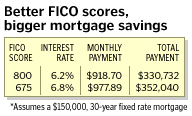
NEW YORK (CNN/Money) -
With the economy on the rocks and no promises from Wall Street, consumers nationwide are stepping up efforts to get their spending under control.
For many, bad habits cultivated during the decade-long bull market have been tough to break. After all, cutting corners to create an emergency fund can seem an impossible task when that $4 latte you've come to rely on is not negotiable.
The good news is, there are still ways you can save by simply being a careful consumer -- ways that won't crimp your style.
Here are our top five suggestions.
1. Make sure you have the right mortgage. New mortgage loans and refinancings have soared since last fall, when mortgage rates hit historic lows. The only problem is that some people are getting a little too enthusiastic, grabbing new mortgages without much thought to the particulars.
| More on mortgages
|

|
|
|
|
A few guidelines: If you plan to stay in your house only a short time, getting an ARM with a low introductory rate for a few years might do the trick. If you're planning to stay awhile (five years or more), it's probably best to lock in a 30-year loan while rates remain low. Another tip? Those in the middle of a 30-year loan might do well to refinance to a 15-year fixed mortgage for the lower rates they provide, said Robert Van Order, chief international economist at Freddie Mac.
To find out how much you can save with a refi, try CNN/Money's Refinancing Calculator.
2. Give your bank account a checkup. Bank fees add up fast -- checking accounts alone costs between $190 and $218 a year, according to Beth Kobliner, author of "Get a Financial Life: Personal Finance in Your Twenties and Thirties."
But you might be able to save $100-to-$200 each year on fees by joining a credit union (a not-for-profit financial cooperative that serves consumers with a common interest), according to the latest data from the Credit Union National Association (CUNA).
For example, banks charge an average fee of $20.22 on checking accounts with insufficient funds, according to a 2001 report by the Federal Reserve. Credit unions charge about $3 less for insufficient funds, according to CUNA.
Banks also charge an average $19.78 per overdraft, according to the Fed, almost $8.50 more than credit unions, which charge $11.35, according to CUNA. At the same time, banks charge about $25 for every bounced check, according to Bankrate.com, while credit unions charge about $17.25 per rubber check, according to CUNA.
| Smart banking
|

|
|
|
|
Even if you're fastidious with your account – it never dips below the required minimum balance and you never overdraw -- a credit union may still serve you better. That's because more than twice as many credit unions offer free checking accounts and free services as banks.
The catch is, not everyone can join. Credit unions serve people with a common interest, so your job, church or community organizations may offer such a membership. To see if you're eligible to join a credit union, click here.
3. Pay credit card debt the smart way. The average American household with at least one credit card carries $8,367 in debt, according to Cardweb.com, and the average credit card rate still flies high at 14.5 percent.
If you've resolved to rein in your balance, you've made the first step – paying double-digit interest for quickly consumed goods (a meal, a vacation) doesn't make financial sense.

First, call your credit card issuer and negotiate your APR (annual percentage rate). To score a better rate, all you often need to do is ask. A report by the Massachusetts Public Interest Research Group (MASSPIRG) found that over half of customers who complained to card issuers about their high rates got them reduced by about one-third.
Next, stop using that bloated card! If you know you can't survive without one, get a new card with a low credit limit and low APR. Only charge what you can pay in full each month and stop using the old card – you'll just inflate your balance and accrue higher interest charges as you pay your balance off.
| Cutting credit card costs
|

|
|
|
|
4. Get good grades on your (credit) report card. If you want to borrow at affordable rates, you need a good credit rating. Three agencies – Equifax, Experian and TransUnion – keep tabs on how responsible you are with credit cards, rent, leases, utility bills and so on.
A number known as your FICO score, calculated by Fair Isaac & Co, is a major part of your credit score. An excellent FICO score -- in the 700s or 800s -- plus solid overall credit reports from the 3 bureaus translate to real dollars back in your pocket.
| A+ credit scores?
|

|
|
|
|
"Ten consumers in a room may all have the same VISA card, but will probably pay a wide variety of interest rates, determined by each person's credit rating," said Craig Watts, a spokesperson for Fair, Isaac & Co.
To get your credit in shape, check with the credit bureau to see if your reports have any mistakes, and ask for the appropriate corrections. Then pay down balances on credit cards as soon as you can – a handful of maxed-out cards will hurt your score, Watts said.
5. Shop around for insurance. It's crucial to comparison shop for any type of property insurance – be it your "home, car, business, boat – whatever," said Jeanne Salvatore, vice-president of consumer affairs for the Insurance Information Institute (III).

Prices vary by hundreds of dollars per year on property insurance, Salvatore said.
Also, consider raising your deductible on your auto insurance, said Doug Flynn, a certified financial planner at Flynn/Zito Financial Planning in Garden City, N.Y. Raising a $500 deductible to $1,000 would lower your annual comprehensive and collision insurance (not liability) by as much as 40 percent, Salvatore said.
Besides, many choose a low deductible, then balk at using it for small accidents.
"Say you have a $500 deductible and get into a fender-bender," Flynn said. "If repairs cost under $1,000, you'll get a small amount from your insurer and face a possible rate hike for a minor accident – or you'll end up paying for the accident out of pocket."
Basically, ensure that your deductible – on both your home and car policy - reflects the amount you can and would part with in order to avoid the hassle of a claim.

|

